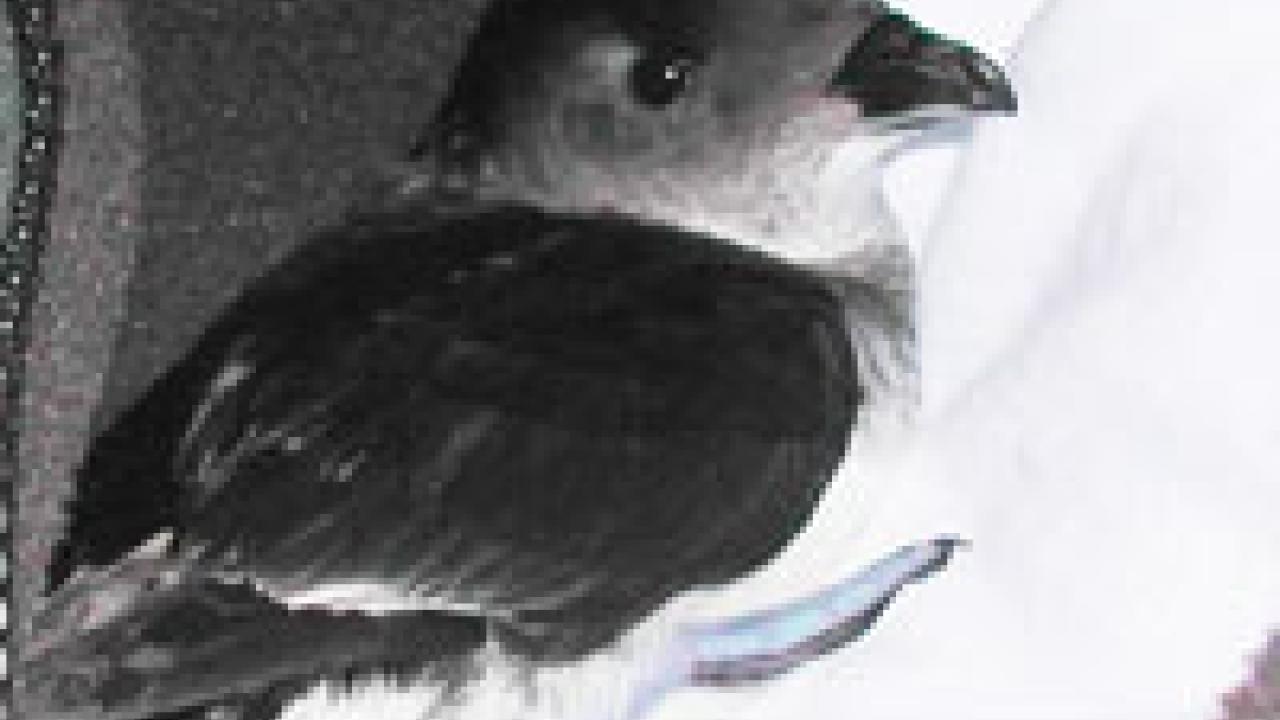Very few smells actually thump the back of your throat.
Putting your nose up to an ammonia bottle does it. So, too, does a sniff from a tiny Tupper-ware of feathers in Gabrielle Nevitt's office.
The feathers have an odor that's hard to describe. Nevitt, a UC Davis professor studying sensory biology in sub-Antarctic birds, says it's "musky." But a descriptor from the cologne counter seems far too weak for this smell. The smell is musk and fear and dirt and 12-meter waves and fish for dinner, all rolled into a single sharp whiff -- and it helps at least one species of small, oceangoing birds get back to its nests alive.
Diving petrels are dove-sized, gray-and-black birds, small but solid, "like sausages," according to Nevitt. They are well adapted to the wild southern oceans, gliding for days in stormy winds and diving 30 to 50 meters underwater to catch food. "Diving petrels are a lot like fish, living in a fluid environment -- for them, the fluid is wind," Nevitt says. "People may think of them as being tied to land, but they're not."
They go to land only to breed and rear chicks. The desolate islands where they dig nesting burrows are also home to many predators, including aggressive birds called skuas that look like giant sea gulls. To avoid the skuas, petrels returning from fishing trips must quickly distinguish their own burrows from similar-looking ones belonging to their neighbors.
"If diving petrels don't find their burrows as soon as they land, they're basically fried," Nevitt said.
But the burrows are hard to see. Many burrow entrances are hidden by vegetation. And petrels, who usually return to their burrows at night, have terrible night vision.
Greg Cunningham, a Ph.D. candidate studying with Nevitt, described working in a diving petrel colony at night. "You hear thousands of birds all around you, singing and calling to each other," he said. But because their vision is so poor, "the birds bump into you mid-flight. You also hear them bumping into each other!"
So how did diving petrels manage to get home safely? Obviously it wasn't by sight. Diving petrels have a very large olfactory bulb, the brain's smell processor, and Nevitt had previously shown that the petrels didn't use it to find food. Could they be smelling their way home instead?
Nevitt and Cunningham tested diving petrels in a simple T-shaped maze. One tunnel led to nesting material from the bird's own burrow; the other led to material from a neighbor's burrow. The petrels liked their own smells best, usually choosing the tunnel that held their own nesting material.
The finding helps us understand how petrels survive their harsh environment, and opens a new area of avian research. "We knew that mammals use a lot of 'self' odors in communication," Nevitt says, citing extensive studies of ground squirrels. "But nobody had done studies about this in birds before."
Nevitt sees many reasons why people need to understand how birds such as diving petrels perceive the world. Some species, including several kinds of albatross, have been decimated by the "long-lining" techniques used by tuna fishermen. Nevitt's research about how albatross hunt has helped fishermen come up with better fishing practices.
Nevitt has studied the sense of smell in several bird species, working both at sea and on the islands where seabirds nest. The experiments on diving petrels were done on two tiny islands in the Kerguelen archipelago in the far southern Indian Ocean. Located 14 days by boat from South Africa, the research location could hardly be more remote.
"Even the South Pole's research base has Internet access," Nevitt said. "But at our Kerguelen site, we only have a two-way radio to check the weather." Researchers visit the islands in teams of two, living in a tiny metal hut and working 30 or more 15-hour days studying the habits of petrels, prions and other sea-going birds.
"You really feel the remoteness of being with one person," Nevitt says. "The birds become your friends. You get to know the penguins that hang out around the cabin."
While studying the birds in their natural habitat is challenging, Nevitt feels it's a key part of protecting the world's most remote places. She is awed by what diving petrels are able to do every day.
"They're just the coolest birds, the best," she says. "Shackleton's last voyage would be no big deal to a petrel."
Nevitt also points out that long-lived bird species have knowledge few humans share. "A 40-year-old petrel has seen a lot," she says.
"These birds are wanderers -- they know so much. They've seen whaling, for example. They've seen the demise of the fishing industry. They've seen things most of us haven't seen. They have gone through incredible changes and have been able to survive."
Media Resources
Amy Agronis, Dateline, (530) 752-1932, abagronis@ucdavis.edu
